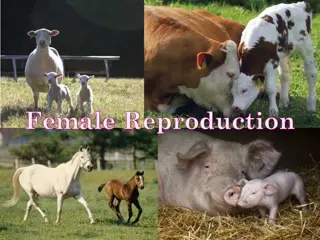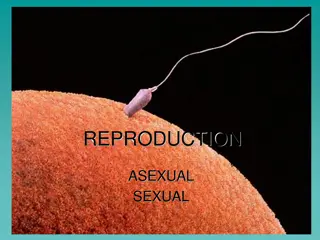
Fascinating Insights into Arachnid Reproduction and Behavior
Explore the intricate world of arachnid reproduction, from courtship rituals to parental care. Learn about the unique characteristics of camel spiders, mites, and other chelicerates, including their varied mating strategies and egg-laying techniques. Discover the diverse behaviors and reproductive patterns within the fascinating class Arachnida and its orders Solifugae and Acari. Delve into the complexities of internal and external fertilization, oviparity, and ovoviviparity, as well as the distinctive roles of male and female arachnids in the reproductive process.
Download Presentation

Please find below an Image/Link to download the presentation.
The content on the website is provided AS IS for your information and personal use only. It may not be sold, licensed, or shared on other websites without obtaining consent from the author. If you encounter any issues during the download, it is possible that the publisher has removed the file from their server.
You are allowed to download the files provided on this website for personal or commercial use, subject to the condition that they are used lawfully. All files are the property of their respective owners.
The content on the website is provided AS IS for your information and personal use only. It may not be sold, licensed, or shared on other websites without obtaining consent from the author.
E N D
Presentation Transcript
Arachnid Reproduction By Audrey Keune
What is it? Commonly called a camel spider, sun spider, or wind scorpion No antennae Two distinct body sections Chelicerae
Sub-phylum: Chelicerata Aquatic chelicerates (horseshoe crabs) external fertilizstion Terrestrial chelicerates internal fertilization, some direct (male genitalia contact female genitalia, but most indirect Courtship rituals common Most lay eggs (oviparity) but some use ovoviviparity (eggs kept inside body until hatching, offspring born live) Differing levels of parental care from none to prolonged
Class: Arachnida Have one or two gonads, located in abdomen Genital opening usually located on the underside of second abdominal segment Most species male produces spermatophore Many have complex courtship rituals Usually lay yolky eggs hatch into offspring that resemble miniature adults Scorpions ovoviviparous or viviparous Usually only female may provide parental care
Order: Solifugae (camel spiders) Usually only has one brood per year (univoltine) Some use direct sperm transfer, others indirect, with male emitting spermatopjore om ground and then inserts it with chelicerae into female s genital pore to do this he flips her onto her back Female then digs a burrow, lays 50-200 eggs, some guard female does not feed during this time Stages egg, postembryo, 9-10 nymphal instars, adults Video showing male using chelicerae: https://www.youtube.com/watch?v=0IUBBhW-ksc Another video: https://www.youtube.com/watch?v=m36r1dI9uMw
Order: Acari (mites) Separate sexes males habe a pair of testes in mid-region of body, each connected to gonopore by a vas deferens, some have a chitinous penis Females single ovary connected to gonopore by oviduct, seminal receptacle for storage of sperm Most sperm transferred indirectly by either a spermatophore deposited on a surface that is picked up by female or by male using chelicerae or third pair of legs to insert it into the female s gonopore Some direct using male s penis Eggs laid in substrate 2-6 wks to hatch, 1st stage larvae have six legs, 3 molts = protonymphs with 8 legs, 3 more molts = adults
Order: Araneae (spiders) Sexual reproduction. Internal fertilization, indirect no spermatophores Males spin small sperm webs onto which they ejaculate then transfer to special syringe-like structures, papal bulbs, or palpal organs, on the tips of the pedipalps of mature males Females usually a good deal larger than males chance of getting eaten Elaborate courtship rituals can include precise patterns of vibrations on web, pattern of touches on female s body, for species with good eyesight (ex. Jumping spiders) gestures and dances
Spiders contd Successful courtship male injects sperm from palpal bulbs into female s genital opening (epigyne) on underside of her abdomen Female reproductive tracts vary from simple tubes to systems that include seminal receptacles, sperm is stored in the epigyne Eggs not fertilized inside the female (usually) fertilized during oviposition when stored sperm is released Lay up to 3000 eggs in one or more silk egg sacs maintains humidity Some species females die after (think charlottes web) others protect by attaching to webs, hiding them in nests, carrying them in chelicerae or attaching to spinnerets and dragging them
Even more spider stuff Offspring pass all larval stages in egg and hatch as spiderlings very small, sexually immature, similar in shape to adults Some care for young- carrying or feeding Most live for 1-2 yrs, some tarantulas live for 20+ yrs
Order: Opiliones (harvestmen, daddy long legs) Some species parthenogenic, most sexually reproducing Direct copulation Some offer a secretion from chelicerae to female (nuptial gift) Sometimes male guards female, many species male defend territory Some post-copulatory behavior, male shakes female s sensory leg may entice the female to mate a second time Females lay eggs from ovipositor, shortly after mating to several months later Some build nests
Harvestmen contd Some species male sole guard for eggs from multiple partners (females may eat eggs), regularly cleans eggs Hatch after 20 days to half a year later 4-8 nymphal instars (most 6)
Order: Parasitiformes (ticks) Egg, larva, nymph, adult
References https://en.wikipedia.org/wiki/Arachnid#Subdivisions https://commons.wikimedia.org/wiki/File:Sunspider.jpg https://en.wikipedia.org/wiki/Chelicerata#Reproduction https://commons.wikimedia.org/wiki/File:Haeckel_Arachnida.jpg https://en.wikipedia.org/wiki/Arachnid#Reproduction https://en.wikipedia.org/wiki/Solifugae#Life_cycle https://en.wikipedia.org/wiki/Mite#Reproduction_and_life_cycle https://commons.wikimedia.org/wiki/File:Ontogeny_Chaetodactylus_krombeini.jpg https://en.wikipedia.org/wiki/Acari https://commons.wikimedia.org/wiki/File:Lycosidae_female_carrying_young.jpg https://en.wikipedia.org/wiki/Spider http://journals.plos.org/plosone/article?id=10.1371/journal.pone.0137181 https://en.wikipedia.org/wiki/Opiliones https://en.wikipedia.org/wiki/Tick#Life_cycle https://en.wikipedia.org/wiki/Pseudoscorpion#Characteristics






















